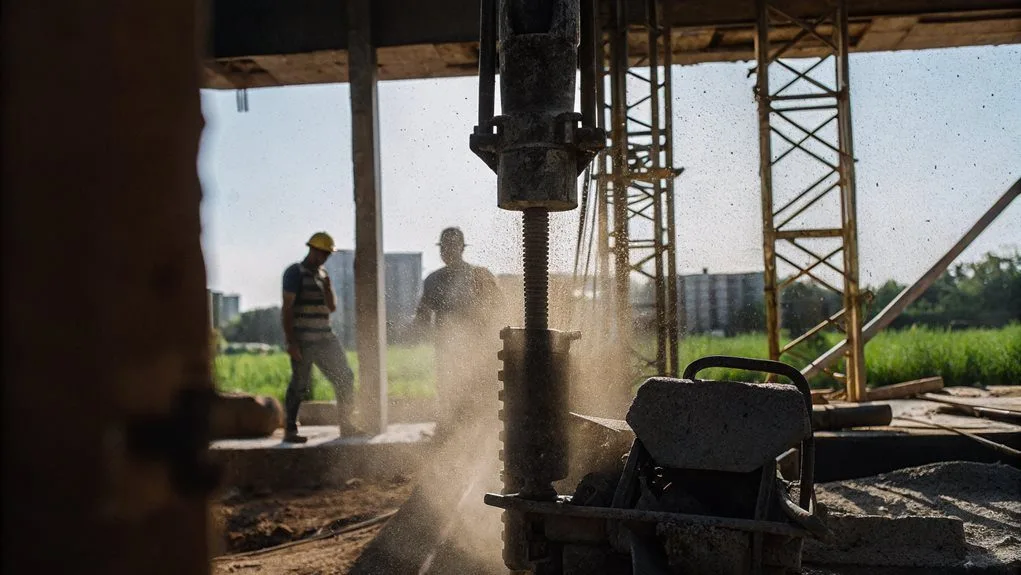If equipment fails on site, you’re in for a world of trouble. Imagine this: idle workers, plummeting production, and a revenue hit that could reach R8,976,000 per hour—yikes! You think that sounds fun? Spoiler alert: it’s not. You might even face costly repairs that feel like tossing cash down the drain.
And let’s not forget the damage to your reputation! When equipment breaks down, it doesn’t just affect your bottom line—it can severely impact client relationships and future business opportunities. Stick around, and you’ll see how to dodge these disasters—trust me, it’s worth it.
Key Takeaways
- Equipment failures cause significant unplanned downtime, resulting in estimated hourly revenue losses averaging R8,976,000 for manufacturers.
- Supply chain disruptions occur, impacting the entire production flow and leading to economic setbacks.
- Repair times increase, potentially requiring specialized labor and resulting in tens of thousands of rand in unexpected costs.
- Idle team members due to equipment breakdowns contribute to operational inefficiencies and loss of productivity.
- Business reputation suffers as failure incidences escalate, making it essential to invest in preventative maintenance strategies.
Causes of Equipment Breakdowns
Ah, the joys of equipment breakdowns.
You know, nothing says teamwork like a day spent troubleshooting ancient machines.
Aging equipment could be an art form, really—accounting for 40-44% of unplanned downtime. Over half of businesses use the run-to-failure maintenance approach, leading to a lot of fun surprises when things go south. Did you know that aging equipment has an average age of 10+ years, making it a leading cause of unplanned downtime?
Don’t you love the thrill of hunting for replacement parts for a dinosaur?
Operator error is another charming contributor.
Just imagine the joy of someone new fumbling with machinery, because who needs training, right?
And let’s not forget the underappreciated role of preventative maintenance, or lack thereof.
It’s like playing Russian Roulette with your tools!
Over-maintenance? A classic move that can wreak havoc, too.
Got any more surprises waiting in the wings?
You almost can’t help but chuckle at the chaos—unless you’re the one stuck in it!
Impact of Equipment Breakdowns
Equipment breakdowns certainly have a way of disrupting your operations, don’t they? You thought everything was running smoothly, and suddenly, you’re facing an R8,976,000 hourly bill for lost revenue.
That’s correct—your plant loses an average of 323 production hours every year. Quite a sobering statistic, isn’t it? In fact, these average costs per hour can reach as high as $532,000, highlighting the severe financial impact of unplanned downtime. The rising electrification concerns only heighten the risks associated with electrical system failures, making it even more critical to address potential equipment breakdowns proactively.
Your plant’s staggering loss of 323 production hours annually is a wake-up call for operational efficiency.
Picture the disruption as team members sit idle whilst you scramble to restart those production lines.
And let’s not even begin discussing the supply chain complications that exacerbate everything!
Whether it’s manufacturing or agriculture, these failures don’t merely cause inconvenience—they represent a significant economic blow.
Maintenance Strategies to Prevent Failures
When it comes to avoiding equipment breakdowns, maintenance strategies are your best friend—and let’s be honest, you need all the friends you can get in this line of work.
So, what’s the game plan? Preventative maintenance comes in hot, with 80% of manufacturing plants swearing by it. It’s like setting an alarm but for machines. Predictive maintenance not only saves costs, but it can also reduce downtime, ensuring your operations run smoothly. This method has been shown to decrease costs by 12% while improving availability by 9%.
Then there’s predictive maintenance—more than half are jumping on that bandwagon for higher uptime and cost savings.
But some folks cling to the run-to-failure method, which seems a bit like playing with fire, don’t you think? Why risk unplanned downtime when analytics tools can keep you in the loop?
You don’t want your equipment having more breakdowns than you have tea breaks!
Prevention and Mitigation Techniques
How often do we really think about what keeps our machines running smoothly? Probably not enough, right?
You know, following the manufacturer’s instructions isn’t just a suggestion; it’s the golden rule. By ensuring adherence to manufacturers’ instructions, you reduce the risk of malfunctions significantly. For instance, cleaning dryer exhaust every three to six months not only speeds up drying times but also reduces potential fire risks.
And hey, training your staff pays off—no one wants a rookie decision to turn a simple hiccup into a full-blown crisis.
Regular maintenance? It’s like getting a check-up before the big game, folks.
Then there’s predictive maintenance. It’s basically fortune-telling for machines.
Not to mention, prioritising tasks based on urgency keeps your critical equipment alive and well.
If you’ve got spare gear, brilliant! Emergency plans are lifesavers.
Economic and Operational Consequences of Breakdowns
You might think you’re immune to equipment breakdowns, but guess what? They’re sneaky little troublemakers that can hit any business. When your sophisticated machinery breaks down, you’re looking at increased repair times and lost revenue, not to mention those awkward supply chain interruptions. Feeling lucky? Yeah, your reputation might just take a hit too.
And let’s chat about downtime—your productivity takes a nosedive faster than you can say “Eish!” Need specialised labour? Good luck waiting. All this adds up, and that’s before factoring in the rising costs of insurance and maintenance.
With repair costs potentially reaching tens of thousands of rand per breakdown, are you really prepared? Investing in preventive steps now could save you from major headaches later. Just remember, ignoring the problem won’t make it go away—especially in South Africa’s competitive manufacturing landscape where every hour of downtime counts!
Conclusion
So, when that forklift decides to throw a tantrum or a conveyor belt plays hide and seek, you’ve got a problem, huh? You can plan all you want, but equipment failures love to pop up at the worst times. Think of it as Murphy’s Law with a wrench. But hey, with smart maintenance and a splash of luck, you might just dodge those costly breakdowns. Just remember, you can’t fix what you ignore—unless you’re a magician, and let’s face it, you’re not!






